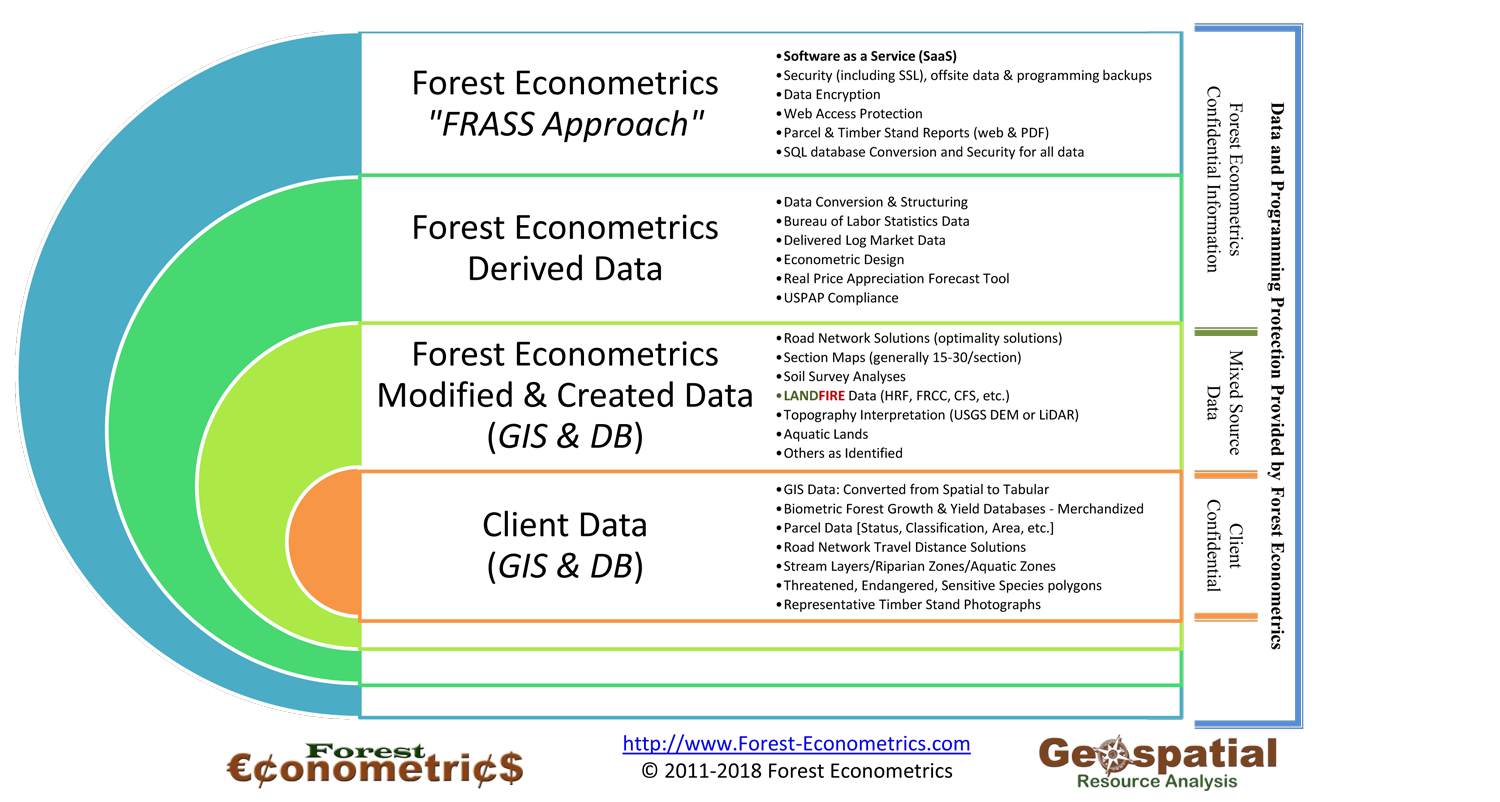Forest data design structures economic and biometric inputs with physical site characteristics to reveal meaningful long-term value results. Forest Resource Analysis System Software (FRASS) integrates Forest Econometrics data with our Client’s physical resource data. The goal is to contextually amplify the existing data through structurally built interrelations within the software system. This leads to financially optimal harvest timing solutions on all timber stands and into perpetuity.
Timber log markets often operate with specific log grades, such as 2 Sawmill, 3 Sawmill, pulp, etc. Therefore, this makes it a desirable recommendation to integrate within the Client’s Forest data design a forest Growth & Yield program capable of merchandizing the trees into logs so that volume can be defined by sorts and grades. Therefore, we have released within FRASS an econometric system oriented for specific log market areas with historic price information. Hence, we make it possible to develop realistic timber price predictions that are matched with detailed forest Growth & Yield data. Most noteworthy, it is repeated on the current rotation, the next rotation, then all rotations into perpetuity.
Forest Data Design

Why Forest Data Design Matters
The built-in architecture of multiple data layers guides users through a system of intuitive operations. This allows identification of economically optimal harvest rotation timing for each timber stand. Furthermore, it is repeated in the current and all future timber stand rotations. Using sequential quadratic programming techniques, the program aggregates anticipated log sort volumes for each species. At each possible rotation combination, FRASS assesses the expected volumes and financial values for the mix of products.
The diagram here is a schematic representation of several diverse data blocks built into a circular shape. At the core resides our Client’s Data complemented by Modified and Created Data from a mix of sources. The next level involves Econometric Data and analysis techniques wrapped around the previous two layers. Ultimately placed within a shell of security encryption and its reporting protocols resides the FRASS Approach. “Forest Resource Analysis System Software Data Design” visually identifies data segments separating the Client’s Confidential Data, Mixed Source Data, and Forest Econometrics’ Data and Programming. The shell of security and analytical power is combined for landowner benefits.
Each level of analysis integrates information necessary to achieve the ultimate goal of determining WHEN is the financially optimal time to harvest. Discovery of sequentially each timber stand to treat (the WHERE). Finally, determine the current discounted value in real terms (VALUE).
Forestland Assets CHANGE every time a tree grows, or dies
The Forest Resource Analysis System Software (FRASS) serves several different potential user types. Each User may have different profile interests, but all share a basic desire. As economic entities, they strive for financial optimization of forestland resource management. Make it affordable.
Using the forest data design fundamentals we integrate, the FRASS program leads users to advanced decision making processes. Based on all aspects of active forest management, it supports forest operational sustainability goals. Further, these are enhanced by unique economic solutions to generate financially optimal timber harvest rotation lengths. Geospatial relationships through the entire land resource explain various challenges to management while identifying opportunities for astute land management practices. Maps are generated in GIS as a visual tool to “contextualize” relationships between features. Images graphically explain how features are spatially and temporally juxtaposed to develop a clear vision of new land management opportunities.
Map it
Static maps display specific resource characteristics such as soils data, roads and rivers, or timber stand boundaries. FRASS also includes an interactive map applet to give users the ability to zoom to a high level of imagery resolution. This interface articulates delivered log market price cycles to create future price predictions combined with growing timber volume by sort and grade. Each system user can apply specific economic portfolios to their forest resource to mirror the forestland investment’s economic realities. Finally, timber harvest timing for the current rotation is considered in context with the next rotation. This is repeated through each rotation into perpetuity. Above all, it generates property value – one timber stand rotation at a time.
Conceptually, this Forest data design approach is understood by many specialists. However, this is the first time financial and physical modeling has been made available to all subscribers. Subscribers run virtual scenarios to reflect changing conditions in economic markets. Likewise, scenario changes in the physical land resource, in any conceivable combination, is effected quickly. Above all, results are delivered in minutes, not days, weeks, or months.
Harvest Timing and Value Report
Property reports are generated on-screen in nearly real-time (request to report – generally happens in less than 30 seconds). When circumstances look “right” to the User, a command can be issued to generate a “Full Parcel Report” that brings all of the data about the parcel together in an exportable PDF file:
- Current property conditions
- Market model assumptions
- Predictions of future timber volumes and prices
- Year of each predicted future harvest
- Volume by species and grade for future timber harvests
- Complete Net Present Value
- For each timber stand into perpetuity
- Combined for the parcel into perpetuity
- Bare land value (Soil Expectation Value)
- All parcel maps in full page view
- Representative timber stand photographs associated with the parcel
- Source data for all reports given in the Full Parcel Report.
The reports generated in the FRASS Platform build additional features for each client. Some have requested Carbon Sequestration levels across the ownership. Other clients have requested anticipated water output through the established stream systems on the parcels. These and other opportunities are available as requested. Each property is unique, each landowner inimitable, and options are nearly boundless.
The Mechanics of Subscriptions
Each Full Parcel Report is generated into a PDF document accessible to the User, at “My Reports”. They are held for a week allowing the User to download them to a local machine. When the reports are prepared (generally less than 5 minutes), the User is notified by an e-mail of the report’s completion. The reports are saved to the User’s desktop and can be viewed, printed, electronically sent to other Users, or passed on for related needs. Through modifying the economic portfolio’s conditions, the User is able to conduct ‘sensitivity analyses’ to see how changes to a single variable impact the ‘bottom line’ of parcel value and harvest scheduling events.
The Potential Users of FRASS include several different groups, all benefiting from the application’s flexibility. Read through the ideas presented here and consider for yourself how use of the FRASS program will fit as a Decision Support System (DSS) within your organization.
Some of the user groups we work with include:
- Commercial Timberland Management Companies
- Non-Industrial Forestland Owners
- Consulting Foresters
- Federal, State, Tribal Forestland Managers
- Conservation Organizations
- Land Appraisers
- University Natural Resource Programs
Putting this into Context
“Too much data” has become a barrier to management and optimal decision making in many industries. Technological advances have responded with creation of business intelligence tools leading to unprecedented democratization of information access and sharing. It is still a common occurrence for forestry decision makers to rely on beliefs rather than knowledge. When managing forestland properties, knowledge leads the way to success. However, it is best when accompanied by parallel managerial beliefs. FRASS comes as a contemporary Business Intelligence System. FRASS brings into focus the entire array of current forest management issues. This is accomplished in temporal and spatial interrelated connections, leading to financially optimal solutions. Timber harvest timing and land value projections are revealed.
A 1996 Gartner Group report pointed out that organizations must make decisions based on accurate, current information—not intuition or collective hunches. They reported that: “Data analysis, reporting, and query tools can help business users wade through a sea of data to synthesize valuable information from it—today these tools collectively fall into a category called ‘Business Intelligence.’”
Make FRASS a core component of your Business Intelligence tool-belt of analysis, reporting, and query tools leading to profitable forestland management.
